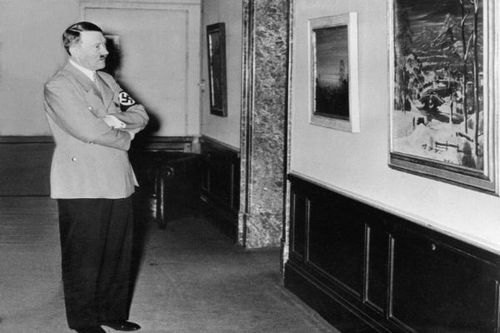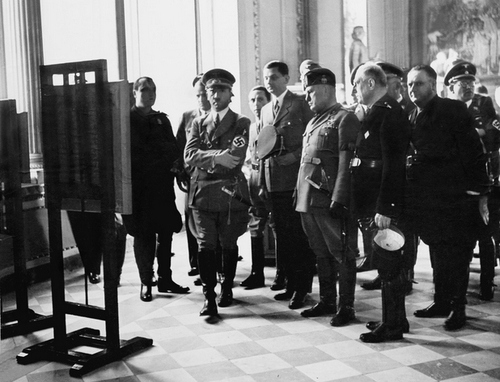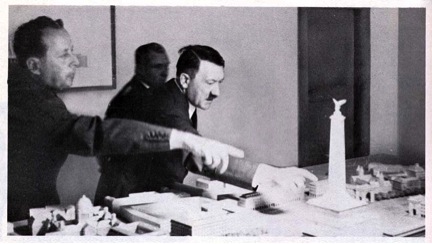
At what point do evil dictators shift from making art to collecting it? Well, when an evil dictator consolidates their power over the most powerful country in Europe, they have less time to paint, and more money and minions to support a collecting habit, so that would be a good moment to make the transition. Here are some of the highlights of Hitler’s transformation from so-so artist to mega collector:
1) Inspirational trip to Italy! Italian dictator Benito Mussolini played host and got to show off all his shiny military toys. Then he thought he’d show off Florence’s art treasures – big mistake! Being the alpha dictator, Hitler decided on the pace, and spent four hours in the Uffizi Gallery alone! According to their tour guide, Benito was bored to tears, whereas Adolf eagerly took in every detail. After the trip, Hitler resolved to step up his game as a collector and conceived of a cunning plan…

Dynamic duo as art tourists
2) The Cunning Plan. Cunning in its simplicity, that is: collect the world’s best and most Germanic art (those two things were synonymous in Hitler’s mind) and bring it to the future cultural capital of the world, Linz, Austria. Every collector needs a place to store and show off their collection, and Hitler grew up around Linz, so the town was a natural choice for his spanking new Fuhrermuseum. The Fuhrer obsessed over the details of the Fuhrermuseum, and the makeover of Linz, right up to the very end of the war. The Fuhrer’s bunker had a special room with a scale model where he would spend hours boring people with the details:

Is this where the plaque with my name goes? No there it is over there mein Fuhrer…
3) Execution of the Cunning Plan. As luck would have it, Allied victory over the Nazis got in the way of the Cunning Plan. A big chunk of it, however, was executed and the collecting in particular.
Hitler’s idea of collecting included paying for artworks, but it mostly consisted of simply taking artworks from people, and then murdering them, and emptying museums in conquered countries to bring Germanic art ‘back where it belongs.’ Because the Plan involved accumulating a massive amount of art all across Europe, the bureaucracy needed to implemented it had to be up to the task. Special military ‘Kunstschutz’ units did the ‘collecting’ and an entire infrastructure of warehouses, trains, transit facilities, was organized to process the items that were stolen in this way.
Several outstanding books have been written on this topic, and the movie “The Rape of Europa” does a good job documenting what is the largest art theft in history. One estimate has over 20% of all of Europe’s art treasures absorbed by Hitler’s collecting teams. Two of the best known paintings ‘collected’ by Hitler for his museum include The Adoration of the Mystic Lamb by Jan van Eyck, and The Astronomer by Johannes Vermeer.
Closing thought on the cunning plan. We all know that judging art is subjective, but for what it’s worth most of the art Hitler loved can now be bought for next to nothing (excluding the Vermeers of course), and a lot of the art he hated is now stratospherically expensive. For example, there seems to be zero demand for works by Hitler’s personal court painter, Heinrich Knirr, whereas Hitler considered Vincent van Gogh’s works ‘degenerate’. As of this writing, van Gogh’s paintings are highly sought after and he is by far the most expensive artist in the history of … well, ever. Records are made to be broken, but again, as of today, only fifteen paintings have ever sold for more than $100 million, and Vincent painted six of those.









